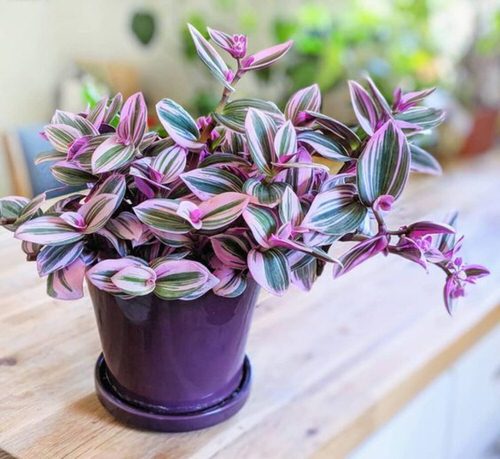Growing Fantasy Venice indoors in a cool way to add colors to your room! Here’s all the information about Tradescantia Nanouk Care!

Fantasy Venice looks like someone painted a wandering jew plant in the best of its colors. It is easy to maintain and offers spectacular shades of different hues! Let’s have a detailed look at Tradescantia Nanouk Care.
Check out our article on propagating Wandering Jew in the water here
Tradescantia Nanouk Profile
Also known as Tradescantia albiflora ‘Nanouk’ and Fantasy Venice, this new spiderwort variety is a result of the cross-pollination of two seedlings of Tradescantia albiflora. This compact variety was made in the Netherlands in 2012.
This herbaceous perennial has an upright and compact broad spreading growth pattern. It features light purple, green, and grey-green-hued strong, healthy leaves. Growing this is a lot similar to other tradescantia plants.
Propagating Tradescantia ‘Nanouk’

Propagating Tradescantia nanouk is quite easy— snip a 5-6 inches long cutting just below the node, remove the bottom foliage, dip the end in a rooting hormone and plant them in the soil.
If you want this to grow in water, place the cuttings in a glass jar filled with non-chlorinated water and keep it in bright, indirect light. When roots develop, transplant them in the soil or continue to grow in the water.
Here are the best types of Wandering Jews you can grow
Growing Requirements of Tradescantia Nanouk

Light
This compact plant prefers partial, filtered, or bright indirect sunlight as it helps it in producing more colorful leaves and improves flower growth. Lack of light can cause the leaves to fade. For best colors, expose it to the mild morning sun for 1-2 hours.
Soil
It’s not finicky about any soil type, just provide your tradescantia a well-draining growing medium because it hates living in waterlogged soil. If you are using just garden soil, add some peat moss or coco peat, or coarse sand to lighten it up.
Improve the soil quality by adding organic matter such as compost, leaf mold or manure.
Watering
Overwatering is more harmful than underwatering; allow the soil to become dry and water it entirely. T. Nanouk can do well in weekly watering. Also, do not allow the plant to stand in water. If you mist your plants often, avoid doing this to it, especially if you’re growing it in a cold and damp location.
Temperature
Tradescantia Nanouk needs a warm daytime temperature, at least above 55 F (12 C). Tradescantia is winter hardy in USDA Zones 10-12, you can grow it outdoors year-round in any frost-free climate. Make sure that the plant is never exposed to a temperature below 40 F (5 C) or above 100 F (37 C) for a prolonged duration.
Avoid exposing the plant to frosty conditions as it can do serious damage to its growth and will also cause discoloration of the leaves.
Tradescantia ‘Nanouk’ Care
Fertilizer
This variety does not require frequent fertilization and over-feeding can make the leaf tips to burn. However, you can feed the plant with a balanced liquid fertilizer, diluted to half of its strength, once in 6-8 weeks to give a boost in growth. If you live in a cold climate, avoid fertilizing in winters.
Pruning
This compact plant has some spreading and wandering habits of its relatives and you can keep it bushier by pinching back regularly.
If the plant is spreading and looking thin at the top, prune the leggy stems and propagate them in the center of the container. The cutting will root fast and fill your plant and will look bushier.
Pest and Diseases
Overwatering can be troublesome for Tradescantia as it can cause fungal infections, root rot, and fungus gnats. If you notice a leggy plant, first check if the soil is soggy, and allow it to dry out completely. Also, remove damaged or rotten leaves or stems.
If you keep the plant too dry, then spider mites can create problems. You can overcome these issues by developing a correct watering plan and encouraging humidity.
Toxicity
The sap of Tradescantia can irritate the skin; if ingested, it can cause mild gastric issues. Keep your pets and kids away from this plant if they are playful.



Love the look of this plant!
Does it go well in mixed planter baskets?
Thanks for sharing your knowledge.
It’s similar to care of a succulent, it’s a tropical plant and doesn’t need a ton of water, so you need to plant it with like plants. I only water mine every two weeks and let it dry out between waterings. It hates wind if you plan out outdoor pottings